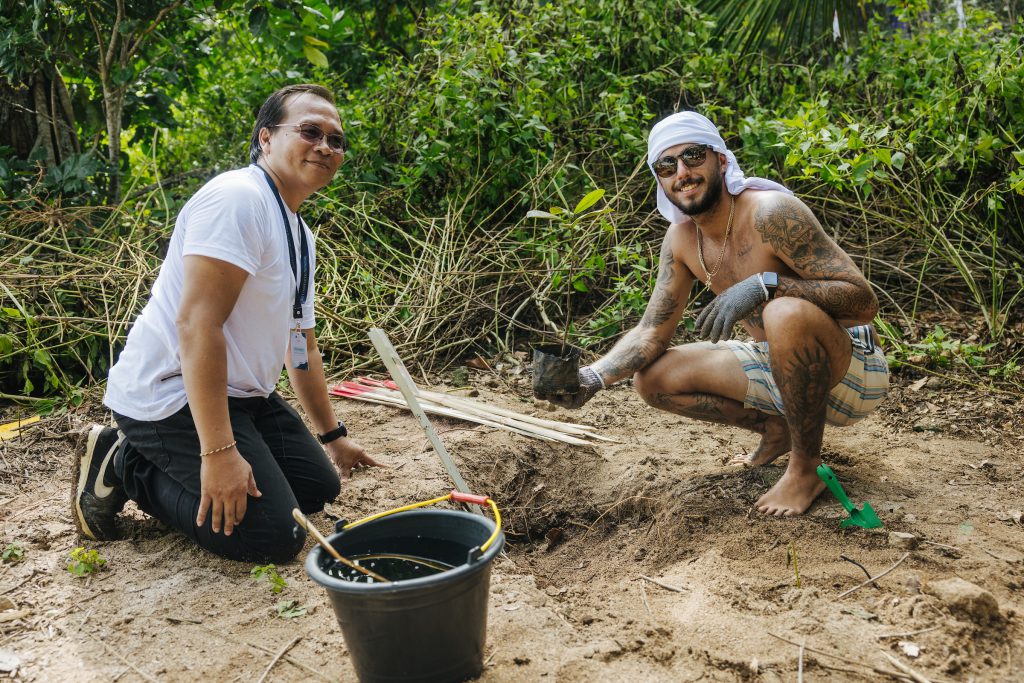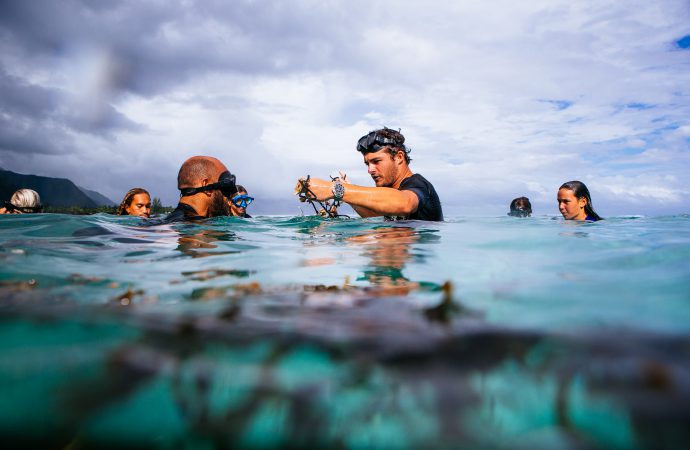The World Surf League is leading the cultural shift away from dominating nature as intrinsic to sports participation, enabling non-binary ecological connection in its place
Ever since the first ancient Polynesians arrived in Hawaii about 1,500 years ago, surfing and connecting with the Pacific Ocean has been tremendously significant in Hawaiian religion and culture.
The recent Sports for Nature Report revealed just how significant the oceans are, finding they generate 50% of our planet’s oxygen while absorbing 93% of the additional global heat and 25% of human-driven carbon emissions. As CO2 levels continue rising, the oceans are being forced to absorb more heat, increasing sea levels, temperatures and acidity.
In Hawaii, native green sea turtles and monk seals are at risk from these consequences, but the resilience of local communities will also be tested. According to University of Hawaii scientists, the two paved lanes used to access the renowned Pipeline and Waimea Bay surf breaks will soon be underwater due to rising seas, storm surges and extreme flooding.
This would be hugely problematic for the World Surf League (WSL), relying on the two iconic breaks for its first two events of the season. But as the 2023 Championship Tour begins tomorrow with the Billabong Pro Pipeline in Oahu, surfing’s governing body is not scrambling to address the deteriorating environmental conditions surrounding them.
Multiple pieces of research (Brymer and Gray, 2010; Fox, Marshall and Dankel, 2021) suggest that sport can play a critical role in enhancing our relationship with natural spaces, consequently generating environmental awareness and concern.
Emily Hofer, chief people officer and purpose officer for WSL, tells The Sustainability Report that the WSL has utilised such lessons as a “foundational, core value of our business” to foster environmental protection.
WSL signed the United Nations (UN) Sports for Climate Action framework in 2018, before announcing sustainability commitments in 2019 that aligned with their three sustainability pillars of coasts, plastics and climate. Starting in 2019 and applied moving forward, WSL:
Became carbon neutral globally: The WSL carbon offset programme was calculated in partnership with the certification organisation STOKE (Sustainable Tourism & Outdoors Kit for Evaluation) from 2018-2022 and WSL is working with One Carbon World this year and beyond.
Eliminated single-serve plastics at our events: By 2050, it has been estimated that there could be more plastic in the ocean than fish. To help prevent this, WSL have committed to eliminating all single-use plastics from their events.
Invested in local communities through activations and an annual grant program: Connectivity between people and institutions at the local level plays a vital role in ensuring sustainable ocean governance (Winther et al., 2020). Reflecting this finding, WSL supports communities in its event locations via local non-profit organisations that protect coastal ecosystems.
Unlike most other sports organisations and governing bodies, WSL committed to nature conservation well before signing the UN Sports for Climate Action framework. In 2016, WSL PURE (Protecting, Understanding, and Respecting the Environment) was founded to ‘inspire, educate and empower ocean lovers’. In 2021, We Are One Ocean (WAOO) was launched to take this inspiration further and ‘preserve the future of surfing for generations of surfers to come’.
WSL PURE grants are awarded to organisations supporting WAOO, bringing together people from over 150 countries and 90 organisations throughout 2021 and 2022.
At last year’s season-opening Billabong Pro Pipeline, WSL partnered with Mālama Pūpūkea Waimea, a grassroots conservation restoration team, to maintain the Pūpūkea and Waimea ‘ahupua‘a’ – a Hawaiian term for a large traditional subdivision of land – for both present and future generations through community stewardship and education.
At 2022’s second event, the Hurley Pro Sunset Beach, WSL partnered with Nā Kama Kai – ‘children of the sea’ – to empower children by connecting them to the ocean and land, instilling love and responsibility for both the natural environment and themselves through education and leadership development.
Alongside the first two rounds of the 2023 Championship Tour, WSL will be working with new Hawaiian grassroots organisations:
– At the Billabong Pro Pipeline (Jan 29-Feb 10), WSL is partnering with North Shore Community Land Trust to conduct critical coastal restoration work.
– At the Hurley Pro Sunset Beach (Feb 12-23), WSL is partnering with Kōkua Hawaii Foundation to engage in wetland restoration and compost education.
“Hawaii is an extremely important market to WSL,” says Hofer, who is also the executive director of WSL PURE. “The work achieved this year will complement our impact from past initiatives”, which includes:
– 1,231 children, youth, and adults educated through Mālama Pūpūkea Waimea
– 1,200 youth educated through Nā Kama Kai
– 4,000 pounds of invasives removed
– 255 native plants planted
– 1 Management Planning Guide drafted with the WSL partner agency Hawaii Division of Aquatic Resources
Embedded into these initiatives is the recognition that each community has unique needs, meaning that any WSL intervention is guided by locals. Across the Championships Tour’s locations, this is often indigenous people that live in harmony with nature.
“We are working hard to be inclusive in this work and we’re thrilled to see that our efforts are also being acknowledged by indigenous communities as examples for others”, says Hofer. “We want fans to see WSL leading change, doing meaningful and authentic work that is truly making a difference and having an impact”.
This wider resonance is achieved through WSL’s efforts to improve ocean literacy. Research suggests that to generate care for the ocean, ‘Informed ocean citizens are central to upholding meaningful actions and best practices’ (Fox, Marshall and Dankel, 2021).
WSL are not only encouraging these behaviours, but rewarding them too. To celebrate World Nature Conservation Day on July 28, 2022, the governing body asked fans to ‘share your sustainability story’ using #WeAreOneOcean. WSL recently surprised six people with $2,000 to continue their ocean conservation work while inspiring others to do the same.
But in addition to WSL’s audience, ‘informed ocean citizens’ also includes professional surfers.
“For WSL athletes specifically, we partnered with Climate Council to educate our athletes on ocean literacy and foundational issues related to climate change and climate threats,” says Hofer. “As we activate around the world with sustainability projects at each of our events, we ensure that before each session, the grassroots organisation hosting the event has the opportunity to educate all WSL surfers and guests about the importance of the work each activation is designed to deliver and why it is unique to that particular location.”
Dr. Rebecca Olive’s latest research that recognises surfing’s capacity to ‘[create] opportunities for experiencing encounters that highlight our vulnerability’ in the ocean, a sentiment that WSL surfers are all too familiar with, is undoubtedly an important factor behind the governing body’s expanding environmental program affecting an increasing number of WSL athletes (learn more about this research from a recent interview with Dr. Rebecca Olive on The Sustainability Report podcast here).
Throughout 2022, 39 WSL surfers participated in environmental initiatives, including Championship Tour surfer and 2022 men’s world champion Filipe Toledo.
“I’m super honoured to be part of We Are One Ocean and do my part to protect the stops on tour that we all love,” he tells The Sustainability Report.
During COP27 in November, the Brazilian sent a special Instagram message to leaders in Egypt urging them to intensify ocean conservation efforts. One month later, the WSL established a partnership for Toledo to co-host a virtual gala alongside global stars including Jason Momoa, Massimo Bottura and Dr. Jane Goodall that highlighted the WSL’s restoration work throughout 2022.
“Presenting the UN World Restoration Flagships was a really special moment and I’m grateful for the opportunity,” says Toledo. “I’m hopeful we can come together to face plastic pollution and climate change head on so my kids can enjoy the ocean as I have.”

Another Championship Tour surfer that has been heavily involved with WSL’s environmental initiatives is Brisa Hennessy. “It’s been amazing to support so many We Are One Ocean initiatives and learn from first-hand experience,” the Costa Rican tells The Sustainability Report. “I was able to help restore coral reefs in Tahiti, support native planting efforts in Australia, do conservation work in Costa Rica and more. There’s so many different ways that you can make a difference. If we all come together to do little parts, it actually becomes one big, beautiful change.”
Yesterday, the WSL announced that Toledo, Hennessy and Dr. Cliff Kapono, ocean advocate and WAOO ambassador, were all recipients of the inaugural WSL Impact Award. “The award recognises individual surfers that demonstrate the greatest impact and outstanding effort to inspire, educate, and empower our global surf community to protect our one ocean while also aligning with our equality and inclusion values,” Hofer explains. “We believe engaging our athletes to speak on behalf of this work inspires fans to engage in more profound ways than any brand on its own can hope to achieve.”
Clearly, WSL’s commercial partnerships are required to enable the mechanisms that inspire fans. “We believe that because of the authenticity and impact of our work, commercial sponsorship interest continues to grow in this space,” remarks Hofer. “As a global sport, we have a unique platform to partner with other global organisations who are also committed to protecting and conserving our global ocean.”
One such example is with Shiseido. The Japanese multinational is returning as the global sustainability partner of the WSL in 2023, supporting WAOO alongside the SHISEIDO BLUE PROJECT to protect the oceans.
Another example is the UN, partnering with WSL on projects in addition to collaborations involving Filipe Toledo, including:
– Taking over the @unbiodiversity Instagram account to share WSL’s work
– Building a coalition of over 100 non-profit organisations and commercial businesses to protect the oceans
In November 2021, the WSL delivered a WAOO petition as a short film to the UN Convention on Biodiversity, calling on world leaders to protect 30% of oceans by 2030. The previous global target under the Convention on Biological Diversity aimed to protect 10% of the ocean by 2020, but evidence suggested this target would not be enough to meet the objectives of the UN Sustainable Development Goals.
“We were excited to see the United Nations Biodiversity Conference (COP15) end with a landmark agreement to guide global action on nature through to 2030 to address biodiversity loss, restore ecosystems and protect indigenous rights,” Hofer says. WSL’s environmental efforts in Hawaii and California have also been boosted recently after the US House of Representatives passed a package of bills in the annual National Defense Authorization Act to help conserve coral reefs, protect marine mammals and deepen understanding of marine ecosystems.
In 2015, the lack of human dominion over marine ecosystems was broadcast around the world following three-time world champion Mick Fanning’s unsettling encounter with a shark during the WSL men’s shortboard final in South Africa.
Surfing will never be able to escape this sense of vulnerability posed by its natural setting, creating ‘opportunities for experiencing encounters that highlight our vulnerability’ compared to land-based sports (Olive, 2022). The priority of surfers won’t suddenly change from accessing waves to environmental protection either (Lazarow and Olive, 2017), but WSL’s understanding that surfing is not above or separate from coastal ecosystems, by ‘recognising the histories, relationships and politics we are immersed in, the rights of the non-humans that live in the waters, the responsibilities we have to develop curiosity for the ecologies we swim and surf in, and to realise our own vulnerability in the interconnections of human-ocean health and wellbeing’ (Olive, 2022), is how the full potential of connecting sport and nature can be realised.
“The ocean is our arena, our office, our inspiration,” Hofer adds. “The global ocean, its waves and beaches, reefs and high seas, is truly our greatest resource and connector. As surfers, we are incredibly passionate about the ocean and protecting it for future generations. This is something the entire business feels connected to and committed to driving.”
Opt into our weekly newsletter for exclusive content focused on sustainability strategy, communication and leadership for sport’s ecosystem.










Leave a Comment
Your email address will not be published. Required fields are marked with *